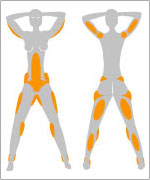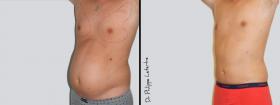Silhouette and face cosmetic surgery Liposuction or lipoaspiration
Body areas favourables to liposuction
 The main intervention areas are:
The main intervention areas are:
- Hips ("love handles")
- Saddlebags
- Belly
- Arm
- Thighs and knees
- Calves, ankles
- Double Chin
- Neck and facial contours
What are the motivations for a liposuction ?
In certain areas, your silhouette is unsightly because excess fat has settled, and you cannot even resolve it with diets or sports. Liposuction does not replace a diet, but may be a "starter" or a valuable aid to a will to lose weight.
The more your skin will be toned, the more the intervention will be effective.
What are the objectives of cosmetic surgery?
With the technique of liposuction which progresses day by day, cosmetic surgery makes it possible to refine your silhouette by sucking effectively and harmoniously deep and superficial fat.
The fat removed will not return, and the scar is very discreet (about3mm).
Importance of 1st consultation
As with any cosmetic surgery, liposuction involves risks to know, pre-operative examinations to practice and protocols to follow.
The first consultation is an important step as it enables to respond precisely, in a personalized and professional way to all questioning.
The objective is that you go back home with all the needed factors to take your decision.
It is also a fundamental step so that your surgeon studies your skin and your fat quality and collects all the information needed leading to the most favourable and adapted to your person conclusions.
What happens during the surgery?
The surgeon will first insert thin blunt cannulas by incising the skin on approximately 3 mm. Through these cannulas, he will then suction your deep and superficial fat smoothly and according to your skin.
A specific elastic bandage is placed after surgery, sometimes associated with a support girdle.
+ What is the type of anesthesia?
According to the case, anesthesia may be local, deep if administered intravenously by tranquilizers or general.
This will be the subject of a discussion between you and your surgeon during a consultation.
+ And the scar ?
There is a small scar of about 3 mm, very discreet.
+ How long is the surgery?
The intervention takes 1h in average but varies from 20min to 3h, depending on the importance of Liposuction.
What are the postoperative courses?
Hospitalization usually lasts one day.
The postoperative courses are not very painful because of the thinness of the cannulas and decreased by a mild treatment of analgesic.
Bruising (bruises) and an edema (swelling) appear on the treated area.
You will have a "modeling" bandage placed.
The resumption of daily activities is fast, between 3 and 6 days.
Sport and great efforts are not recommended to you during the first 3 weeks.
What is the expected result of a liposuction ?
The objective of this intervention is that the contour of your silhouette becomes thinner and your curves harmonious.
You must wait about 5 weeks to be able to appreciate the final result, the time required for your skin to adjust to your new silhouette for optimum results.
Good combination: Liposuction and skin lift with CelluM6 or palpate and roll massage that will significantly reduce cellulite.
What are the possible complications ?
Following any operation whatsoever , certain complications can occur, the first ones related to the medical activity and the others to anesthesia.
Although possible complications only represent a small percentage, it is necessary to know them.
+ What are the specific risks of anesthesia?
During your obligatory talk with the anesthetist, he will inform you in detail of the risks of anesthesia.
It is useful to know besides that during the last twenty years, the risks have not been eradicated but remain almost insignificant.
+ What are the specific risks of the surgery?
During the consultations with your surgeon all the possible complications will be detailed to you .
To inform you in advance, here are the possible risks:
- An infection which may require antibiotic treatment.
- Hematoma, bleeding and poor healing can be observed but rarely serious.
- Thromboembolic accidents (phlebitis, pulmonary embolism), the most serious complication, are exceptional and precautions are taken to reduce risk.
These informations given by Dr. Philippe Letertre should only be a help or a supplement to your surgeon’s consultations
Our space "Questions / Answers" is also available for you.
Feel free to contact Dr. Letertre
so that he could meet your expectations.



